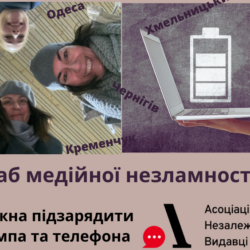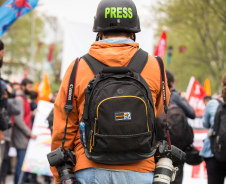Despite ongoing strife and the daily challenges of reporting on a two-year invasion, Ukraine’s news media has never been stronger – or in greater danger, says Oksana Brovko, chief executive officer at AIRPPU (Association of Independent Regional Press Publishers of Ukraine) in an interview for Lucinda Jordaan and World Association of News Publisher.
On February 24, 2022 Russian forces initiated a full-scale military invasion of Ukraine that continues today. It’s a war Ukrainian media were expecting, but not fully prepared for, and many journalists and news titles were sacrificed.
“Before February 24, 2022, most Ukrainian newsrooms faced the same challenges as most media all over the world: we were thinking about monetisation strategies and discussing paywalls for digital media, fighting for young audience for our news sites and planning the future for our print newspapers,” recalls Oksana Brovko, chief executive officer at AIRPPU(Association of Independent Regional Press Publishers of Ukraine).
“But February 2022 changed everything. From the beginning of the month, we already lived in anticipation of the full-scale invasion: we collaborated on evacuation plans, on managing staff and coordinating journalists should the war begin. When the full invasion started, we were ready – but we were not all ready at the same time”.
Many news titles fell, confirms Brovko. “It’s difficult to calculate exactly as most of them were small, super local media, but Ukraine’s Institute of Mass Information (IMI) estimates that at least 230 titles succumbed”.
Newsrooms in occupied territories, and cities in active conflict – Zaporiz’ka region, Kherson and Chernihiv – were closed, she adds. IMI estimates that Russian shelling destroyed or damaged eight media offices during 2023 alone.
“At the time, the main issues for the media were managing between private life, the mobilisation of staff, security, and the work of the editorial offices. The main thing is that we did it together: all members of the Association supported each other. It was a time that urgent, clear organisational support was needed, and given”.

Adapting to strife and circumstance
Some newsrooms managed to restart within a week or two, relocating offices and working remotely, or “under shelling, from within the bomb shelters – then continued their work 24/7.” Brovko cites two examples: “Our colleagues from Kherson – newspaper and digital media Hryvna – restarted their news site and published their newspaper even though most of their staff were not in Kherson, as their office and printing house were destroyed”.
A similar fate befell a small local newspaper in Orikhiv, a city on the frontline which is facing the most active attacks these days, adds Brovko.
“Orikhiv had around 16 000 citizens before the war, and now there are less than 1000 people. Their editorial office was destroyed, they were evacuated to Zaporizhzhya (60km away) but still published their newspaper and delivered it to the citizens with the support of the military.”
Journalists faced life-altering change: some joined the frontlines, some sought safety, and some were forced to pivot from their lifestyle, business or cultural beats and were thrown into the complexities of conflict reporting.
Examples include former lifestyle correspondent Halyna Yakushko, now a freelancer working with regional, national and international broadcasters, including Radio Liberty, BBC Ukraine and CBC.
Ukrainian journalist Svitlana Oslavska was a non-fiction writer and book reviewer who started documenting war crimes for the Reckoning Project, and has since had several articles published in TIME magazine.
A world of support and financial aid
From the onset of the invasion, Ukraine sent out a resounding call for international aid. AIRPPU did too, and immediately launched a Support Hub for Regional Media.
“We are happy that we are not alone in this fight for democratic values. From the very beginning of the full invasion we asked for help, and we received that: from first aid kits, bulletproof vests, and nuclear safety kits for journalists to financial support for evacuation, and equipment for content production and development,” – notes Brovko.
“WAN-IFRA and WAN-IFRA Women in News, the Ukraine Media Fund, NWT Media, Bonnier News and the Swedish Media Publishers’ Association, Schibsted and MBL from Norway, Politiken and Danske Medier from Denmark, Sanoma, Medialiitto and New Media from Finland, Wyborcza Foundation from Poland, MDIF – these are not all, but a big part of our partners who helped, and are still supporting regional independent media in Ukraine.”

Ukraine media’s Rubicon: a common collective challenge
According to the Institute of Mass Information, by July 2023, 70 journalistshad been killed by Russian forces since the invasion – at least 12 filming crews and individual journalists came under Russian fire in 2023 alone. While journalists’ safety is still paramount, Ukraine’s media now faces a Rubicon, in ensuring the country’s press remains free, says Brovko.
“The main challenge for Ukrainian media now is to build the best professional strategy for independent press and to protect press freedom during and after the war. Strategically, institutional support for Ukrainian media, especially for local press, is now most-needed and important. Help us to fight – this is our common challenge now”.
Robust, yet not fully free
Ironically, the war – riddled as it is with disinformation and propaganda – has placed Ukrainian media in perhaps their strongest position ever, dire as circumstances are. “That is because we are working on it. We are communicating with the government and we have support from our donors and partners, so we are not dependent on the politicians and oligarchs”.
Historically, Ukrainian newsrooms are prone to influence peddling, says Brovko: “It’s very easy to influence the local newsroom with additional payments, subsidiaries, financial support from oligarchs or politicians. That’s why it’s extremely important to protect the local press, and to provide institutional support, so they will not be dependent on any politicians or oligarchs.
Cybersurveillance, smear campaigns against journalists and informational restrictions also pose further challenges to media freedom, adds Brovko. “It’s impossible for journalists to go to the frontline without permission, or to write or publish a video on an active explosion. That is understandable. But we struggle with the idea of a government that wants to limit our frontline reportage”.
AIRPPU has teamed up with other non-profit and media organisations in Ukraine, in an open call for frontline access, as well as access to soldiers and military staff, and to report on that.
The threat posed by reported surveillance of journalists is not as easy to overcome. “It looks like we are at the beginning of a big problem, and if we are not strong right now, we will have a bigger problem in the future. That’s why professional support from international organisations, and institutional financial support for independent local press is so crucial”.

Ukraine’s media landscape – over a decade, at a glance
The progression and development of Ukraine’s media can be largely attributed to digit-tech advancements such as the ease of online access, and increasing uptake of social media platforms
Tech and Big Tech advancements, along with increasing online access, accelerated media development and, in February 2014, a Facebook post by journalist Mustafar Nayem triggered another wave of protests that would become bloody.
State crackdown on the Revolution of Dignity (the Maidan Revolution) resulted in the death of 100 citizens. President Viktor Yanukovych fled the country. And, In March 2014, Crimea was annexed.
According to a Reporters Without Borders report on a decade of Ukraine’s media development: “The uprising toppled Viktor Yanukovych’s presidency and paved the way for major improvements in the working environment for journalists.
‘Ukraine’s ranking in RSF’s World Press Freedom Index has gone from 126th in 2013 to 79th in 2023.’
The report attributes “legislative reforms, media transparency, a stronger role for independent media outlets” to the progress made by Ukraine’s media over the past decade.
These include, amongst others:
- the creation of a public broadcast media group, Suspilne, in 2017
- Tenfold increase in investigations into attacks on journalists
- Greater media transparency: 68% of media are now transparent, particularly about their financial and editorial situation, compared with just 14% in 2018 – and A new media law passed in December 2022 brought Ukraine in line with European standards, increasing transparency into media ownership.
Source: World Association of News Publisher.















